
|
|---|
|
Beginners Guide to Electric Vehicles Introduction Electric Vehicle Types Choosing an Electric Vehicle Charging Technology Charging Your EV Home Charging Solar and Ways to Reduce Your Bill Contact the Author |
Electric Vehicle Meter Installation If you haven't visited my main EV meter page be sure to start there if you came to this page from a search engine. The first step to start the installation was to telephone Southern California Edison and schedule an onsite meeting with the power planner and my electrician. At this meeting the planner examined my infrastructure and explained what Edison expected. Specifically, my electrician was going to be responsible for supplying all the materials for the installation except the meter head. Edison required installation of a utility pull box. This particular box receives the incoming feed from the utility company and splits it off for two meters. Southern California Edison will not allow you to tap off the main meter. Edison calls for the box to be 36 inch tall, which makes installation unrealistic for most homes. In my instance Edison gave me a variance to install a 26 inch tall pull box to fit. I have heard feedback rom some electricans that some cities are giving them a difficult time using the 200 amp rated pull box that I used. A few things I want to relay. I have heard some cities are inspecting the entire installation, including the pull box. The utility is responsible between the meter and their grid, and the local municipality is responsible for beyond the meter. Call them on their determination. In my instance, my calculated load including two electric charging stations is 185 amps, under the 200 amp rating of my pull box. I have gotten some questions concerning the lugs as to where to get them. Any electric supplier should be able to get them. However, it is possible that installing these lugs may void the UL listing on the pull box. ` Here is some electrician info from Southern California Edison: Electrician Info Guide Links to pull boxes: Cooper B-Line Boxes Milbank Pull Box I used the Milbank PB-012. We added three stepped set of lugs to allow for branching into the two meters. I submitted the box cut sheet to Edison and once they agreed to allow its use we waited another three weeks for the installation date. Next, I attained an electrical permit from the City to install the project. Usually, this is accomplished by the electrical contractor, but in this instance I opted to do it myself as I have experience in this field. Be prepared for a stunned look from the building and safety staff as many cities have never issued a permit for this type of service. I strongly suggest you bring with you a copy of your utility's electric vehicle page explaining the service. Be sure to plan for the inspection by calling in the request early the day before the install. In the case of the City of Santa Clarita they will not accept inspection requests later than 2pm the prior day. If you can't be inspected Edison will not re-energize your panel. That could be a long night without power. Greg my electrician arrived at 7:45 the morning of the installation. He had already done much of the work as in the previous days he had broken out the stucco, drywall, and installed the meter pedestal. At 8am the lineman from Edison arrived. The first step was for the him to disconnect the service. This is accomplished through a small underground electrical vault that is situated within the utility easement of every fourth house in my neighborhood. 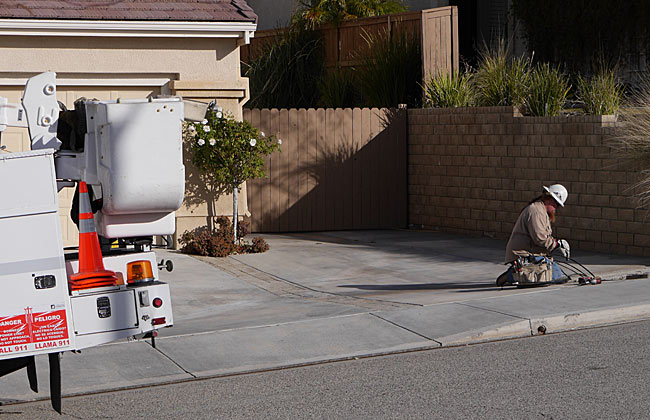
Once the service was disconnected a rope was taped to the end of the feed and the lineman pulled the lines into the underground conduit to allow space for the pull box to be installed. 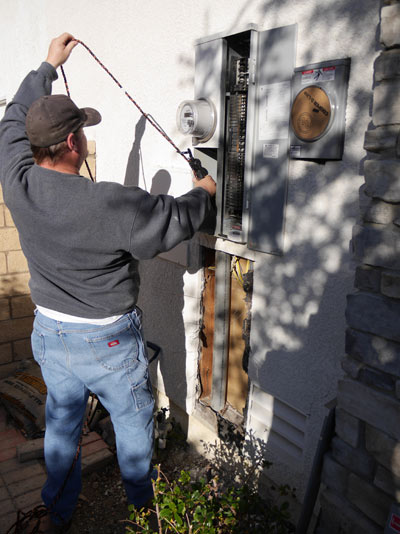
Once the house was disconnected from the grid my electrician went to work installing the pull box. From the box he ran wire to the new meter pedestal and then onto the service panel situated on the other side of the wall in the garage. From the panel he ran wire to the electric car charging outlet. Although my electric car charging station only draws 16 amps of power with a 20 amp circuit breaker, we sized the wire to allow for a 30 amp circuit. In the future the system can be upgraded to a higher amperage charging system. The entire system needs to be grounded so a copper bonding wire is run to my grounding rod located a few feet away. Here are two good links presenting EV guidelines within Riverside County and Riverside City. Riverside County EV Handout Riverside EV Handout 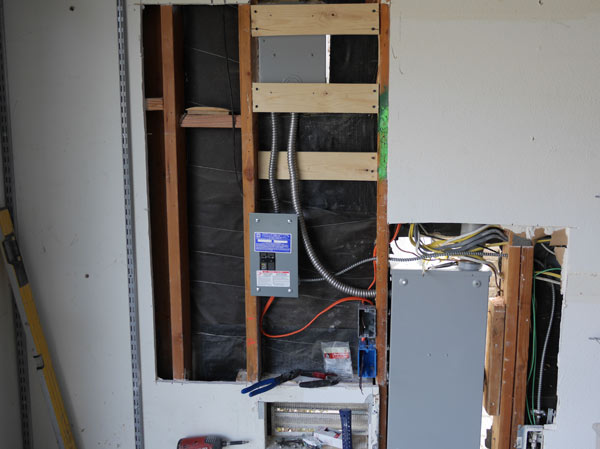 You are looking at the garage side of the installation. In the upper left is the meter pedestal, below that the new service panel that can accomodate two circuits. This particular box can accomodate 60amps of service. There are two outlets to the right of the service panel. Once is 240 from the EV panel, and the other is 240 from the standard home panel. To the right of that is the backside of the utility pull box. In the lower right hand corner is the grounding rod. Greg worked nonstop until about 1:30pm when the City inspector arrived to inspect the project. It is extremely important that we passed this inspection as if we did not, Edison would not re-energize the house. That would mean going overnight without power. The inspector verified the wire gauge, circuit breaker size, bonding, and service panel capacity. He had never seen an EV meter installation so he was curious to learn about the project. He passed us and before departing he reminded me that he needed to return to inspect the lath for the stucco repair. Once in his car he telephoned Edison to let them know the installation passed City inspection. A few minutes later the Edison lineman arrived and went to work reconnecting the service panel to the grid. Our power was back on at 2:30pm. 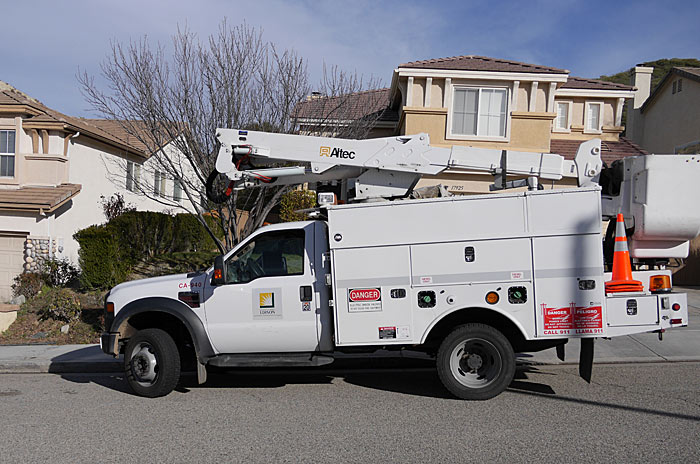
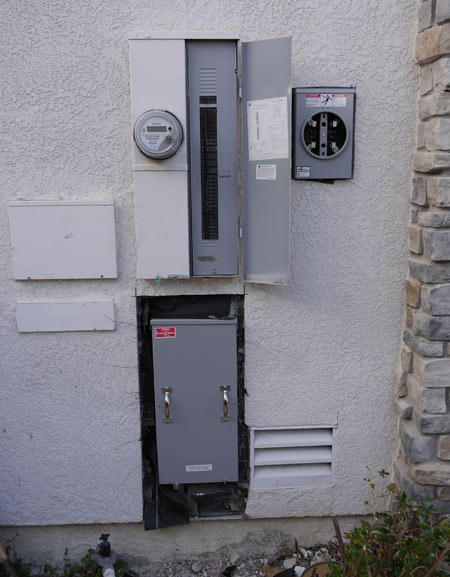
To the left is my telephone and cable television service boxes. The upper middle box is my main service panel. Below that is the utility pull box where the incoming line branches off. The box in the upper right is my EV meter pedestal. 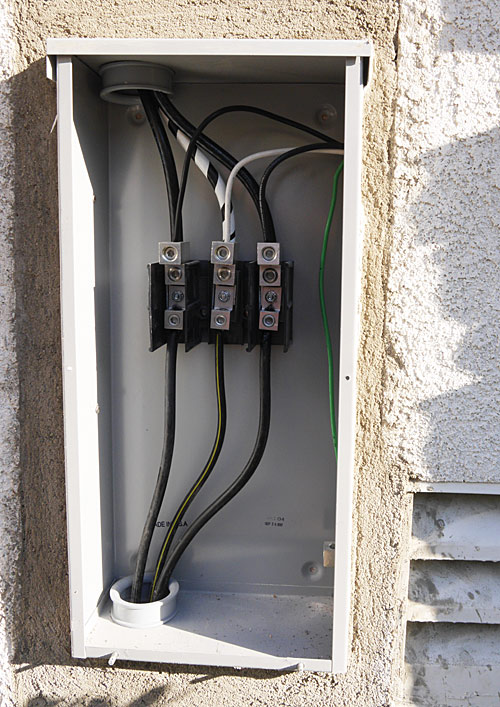
Wide view of the open pull box 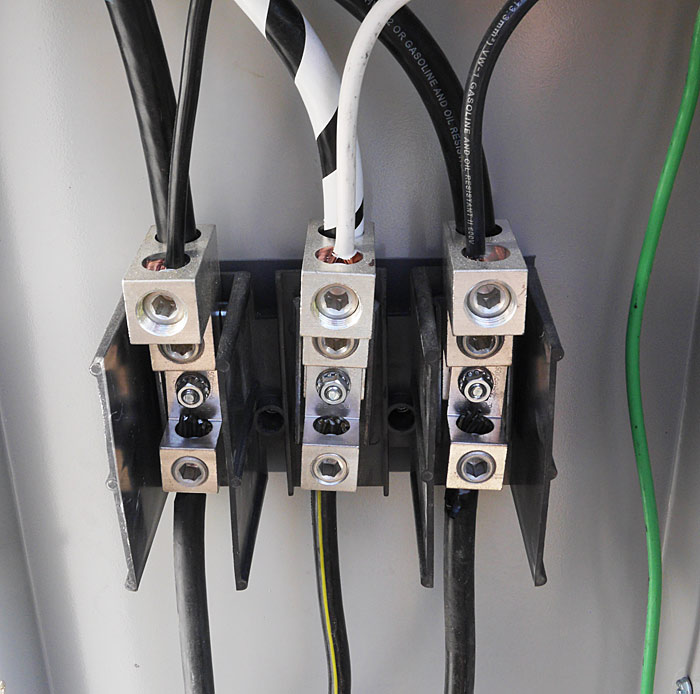 Closeup of the inside of the pull box showing the 6 gauge wire connecting the new meter. We took the extra time to install the equipment inside the wall and will repair the stucco around the new boxes. Too many houses look like industrial complexes with surface mount boxes and conduit strapped to the wall. Solar companies are notorius for running ugly conduit down the sides of houses and I did not want that look. Next we installed new drywall and hung the electric vehicle charging station on the wall. 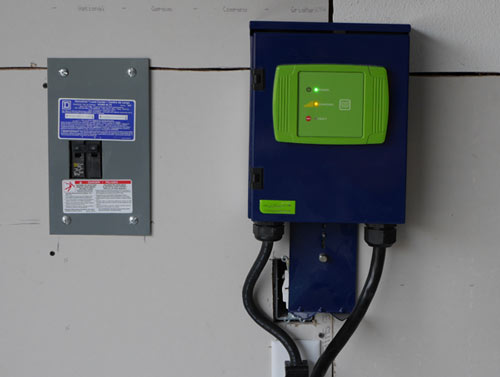
While I had my electrician in the wall I asked him to install a second 240 volt outlet connected to the main service panel. In the future I will be installing solar and I may want to plug the charging system into the main house during the day for months that I have surplus power. I will probably never use it, but since the wall was open I asked him to install it as it wasn't much trouble. 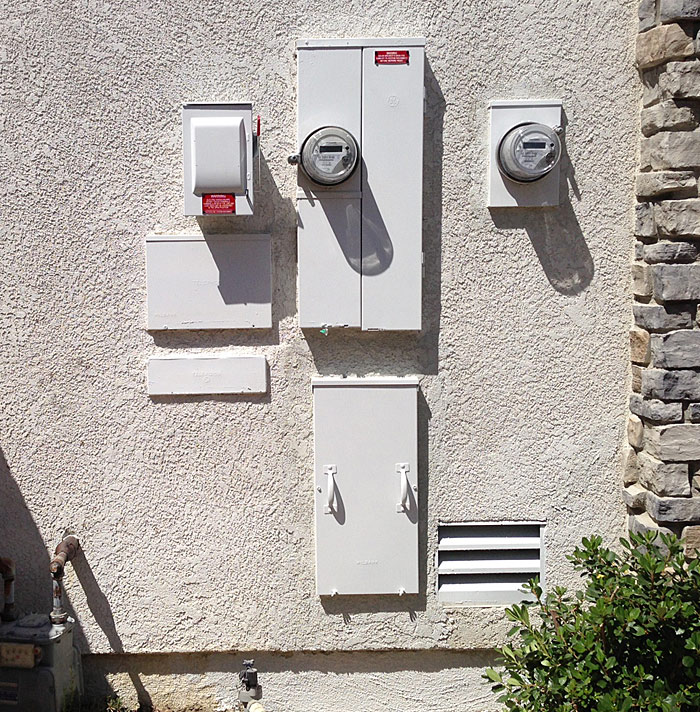
Here is what the side of my house looks like with the stucco repaired. The wall includes my cable tv access panel, telephone panel, solar system shutoff, main electrical service panel, electrical pull box for splitting the incoming line, and the new electric vehicle meter. |